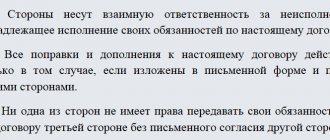Substance of the document
A collective labor agreement is an internal document of a specific company, the main task of which is to establish certain provisions for labor activity in it. A collective agreement, as its name suggests, is always signed by one employer and a group of its employees.
The presence of a valid collective agreement in the organization is not mandatory. Unlike an individual agreement, the drawing up and signing of a collective document is rather an initiative of one party rather than a direct responsibility.
Since a collective agreement enshrines numerous aspects of work, it is convenient to conclude it in a large organization in which professional activity is characterized by a large number of various nuances, features and provisions. For example, in some large companies, employees are provided with preferential housing - in this case, the collective agreement will contain the conditions for its provision, as well as other nuances related to it.
One party to a collective agreement is always the employer, represented by a responsible representative of the organization, who has the appropriate authority to sign this document. Most often, such a representative is the immediate manager of the company or the head of the personnel department. Sometimes a legal adviser is involved in this action. The second party to the contract is always the employees themselves, namely the body that represents them. These two parties, through joint negotiations, agree on important nuances and features of the content of the document.
The validity of a collective agreement may concern both the entire team and its individual parts, for example, a certain structural unit. In some cases, a collective agreement is drawn up and signed for a separate branch of the organization.
With regard to the content of the document, it must include all provisions of labor activity that were not reflected in the individual employment contract previously concluded by the parties.
https://youtu.be/zPAY26EwtUo
Collective agreement - is it mandatory or not in 2020, general information
One of the methods of regulating relationships within the framework of labor legislation is a collective agreement. This is a global agreement between the employer and the entire work team as a whole, regulating various nuances of their interaction and suggesting the possible inclusion of various additional conditions in relation to both the obligations and rights of the employees themselves and the obligations and rights of employers. At the same time, the collective agreement refers to a special type of local regulations of the organization, and each party is responsible for its compliance.
Such an agreement can be concluded not only between the employer and the workers of the organization as a whole. The legislation provides for the possibility of concluding separate collective agreements in branches and other divisions of the company. This approach allows us to determine the most profitable and effective conditions for interaction and cooperation between the parties.
From the point of view of jurisprudence, a collective agreement refers to one of the basic forms of social partnership - mutual regulation of various aspects of labor relations. Higher levels of social partnership can be called regional, sectoral or intersectoral agreements. The standards of a collective agreement cannot contradict the current standards of labor law, as well as standards established and adopted within the framework of more significant levels of social partnership.
Issues related to the procedure for concluding a collective agreement, its content and the responsibility of the parties to each other, including regarding the execution of such a document, are quite strictly regulated by the current labor legislation, as well as other legal documents and acts in the Russian Federation. However, with all these features, importance and significance of the collective agreement, it is not a document that must be present at the enterprise without fail. You can read more about when a collective agreement is mandatory and when you can do without it.
Validity period of the document
Unlike an individual contract, which may be of unlimited duration, a collective document is always concluded for a certain period. The validity period must begin counting at the moment the document is directly signed by the authorized parties. Current labor standards limit the validity of a collective agreement to 3 years. After the expiration of the maximum period of validity, the parties have a legal right to renew this document.
However, as practice shows, the optimal solution would be to conclude a completely new agreement. In this case, it will be possible to immediately make the necessary changes, revise some provisions and make other required amendments. Often these changes also affect the amount of remuneration established for employees. It should be revised in accordance with the current economic situation in the country, as well as other circumstances that will be relevant in a particular situation.
In fact, the procedure for extending a contract is not much different from the procedure for concluding a new document. It also involves the creation of a special commission and preliminary approval of all provisions of the document, even if no significant changes have occurred in its content.
Cases for drawing up a contract
As mentioned above, a collective agreement is a document created at the initiative of one of the parties to the labor relationship. Therefore, its creation is usually due to:
- Resolving disputes between employees and management.
- Change of management of the enterprise.
- Reorganization of the enterprise.
It is also possible to draw up and conclude a document in other situations, if one of the parties sees the need for it.
Main stages of registration of a collective agreement
The procedure for drawing up a collective agreement includes the following main stages:
- The beginning of formal discussions of the nuances between the parties. As a rule, they begin after one of the parties receives written notice of the need to create a collective document. In this case, negotiations must be carried out within 7 subsequent days. During this time, the responsible person must decide on the formation of a special commission, and also decide who exactly will be part of this body. It should be remembered that representatives of each of the parties must be present on the commission, and in equal numbers. After all formal procedures have been carried out, the main stage of negotiations begins. It discusses the main aspects and nuances of the content of the future document.
- After the draft of the future agreement is drawn up, it is approved. For this purpose, special questionnaires and questionnaires are created so that all employees can express their opinions and make appropriate proposals. All information received is recorded in writing for subsequent analysis.
- If the parties cannot reach a common decision regarding certain provisions and nuances, the responsible persons create special protocols that indicate this fact. Information about the essence of a particular proposal is entered there, as well as about objections that were accepted from the other side of the labor relationship.
- The next stage is the creation of the main draft of the future collective agreement, which is drawn up taking into account the information received after questionnaires and surveys. Printed draft agreements are provided to employees for review and approval. If the parties still have certain disagreements, further negotiations are held. Their main essence is to find an optimal compromise that would suit both sides of the labor relationship. If the differences cannot be resolved, the document is signed in those parts that suit everyone.
- The signed draft document, together with a formalized protocol of existing disagreements, is sent for the official registration procedure. It is carried out in accordance with the current rules of record keeping.
- The signed document is considered to have entered into legal force. At the same time, it must also indicate the exact validity period. As a rule, a collective labor agreement is concluded for one year. In this case, it will be necessary to renew or renew it every year.
Did you find this article helpful?
Share with your friends! all articles
How to approve
The procedure for approving a design documentation is a rather complex and lengthy process:
- Identify employer and employee representatives. The employer can be represented by an individual entrepreneur or the director of an enterprise, as well as any authorized person. A trade union can represent workers. If this is not the case, then representatives are selected by secret ballot. The negotiation period cannot take more than 3 months. For this period, all participants are released from work while maintaining their average earnings. Also, participants in the process cannot be subject to disciplinary action or dismissal. If you wish to hire an expert, the cost of his services is paid by the initiator.
- Present the project. The draft agreement is presented by the party initiating the negotiations. All points must be voiced at the meeting. However, conditions may differ from labor legislation only in the direction of improvement.
- Notify about the start of negotiations. The initiator must notify the other party of the need to begin negotiations, as well as set a date and time. The recipient of the notification may make adjustments to the start date of the process by agreement.
- To negotiate. Negotiations officially begin from the moment the second party responds to the initiator’s notification. Avoiding negotiations will result in a fine. The maximum time for starting the procedure is 7 days after receiving the notification.
- Form a single representative office. This is only necessary if there are two or more trade unions operating on the territory of the enterprise. The representation must include at least one member from each trade union.
- Condemn the project. Labor legislation does not regulate the number or content of contract clauses. If disagreements arise, specialists may be involved in the process. Each party has the right to make its own adjustments to the document. The final content of the document must be agreed upon point by point.
- Approve the project. The project is approved after its presentation at a general meeting of all employees of the enterprise. The final decision is made by a majority vote.
- Drawing up and signing a protocol of disagreements. If during the negotiations the parties still have disagreements, they should be recorded on a special form for further consideration. If there are no disagreements, then the negotiations are over.
- Registration of CD. The collective agreement must be registered with the labor authority within 7 days after official signing. This is necessary for legal verification of the document.
The maximum validity period of the CD is 3 years. After the expiration of the term, it is accepted again with the possibility of making changes.
Thus, a collective agreement is not a prerequisite for the functioning of enterprises with hired employees. Such a document is formed on the basis of agreement of the parties and cannot worsen the current situation of employees.
How it works
The collective labor agreement, as soon as it was possible to conclude this local legal agreement, immediately applies to each and every employee registered in the organization. It applies equally to those who took an active part in the selection of representatives and to those who were at that moment amorphous. The Code of Conduct will continue to be valid in the future for every employee hired.
According to the legislation of our country, there is no such standard that would speak about the need for a collective agreement. This document is not required to be concluded. On the other hand, a number of norms of the Labor Code say that some issues can be resolved precisely through the labor contract and nothing else.
Only a collective agreement can normalize the following aspects:
- changing the length of the working day if the conditions for this are harmful or dangerous;
- shift schedule;
- reducing working hours at night;
- granting leaves for additional reasons when salaries are not maintained;
- application of labor standardization methods determined individually in the company.
More recently, in 2012, a new resolution was adopted. According to this legal act, the employer does not have the right to refuse to conclude a collective agreement if, according to certain norms of the Labor Code, he has to resolve an issue from among those described above, that is, not considered in other documents.
What's inside?
So, we found out whether a collective agreement is mandatory for an LLC, and came to the conclusion that no, such a document is not required, although it is possible to draw it up. But what should you write inside if you decide to implement it at your enterprise?
According to the law, it cannot be said that a collective agreement is mandatory, but there are requirements for what it should be if they decide to conclude it. A specific exact structure and content has not yet been developed, so the lawyers of each individual company decide this issue independently. It is generally accepted that in a particular case, employees and the manager are well aware of the specifics of the workplace, and it is on the basis of which they choose the conditions that fit into the local regulatory act.
About the content and structure of the document
Contents of the collective agreement
https://youtu.be/PQnUg6a5pfE
Article 41 of the Labor Code of the Russian Federation defines an approximate list of issues that should be considered in the Employment Agreement. But this list is advisory in nature and helps to roughly imagine what a document should look like so that it does not violate legal requirements.
In total, there are several types of basic questions:
- Forms, systems and mechanisms related to remuneration. It is necessary to write about what factors are taken into account when calculating this indicator.
- The second group is obligations to ensure the employment of employees and provide them with special benefits.
- There must be a description of the standards governing social services and labor protection.
- The fourth group is the norms that are contained in regulatory legal acts adopted at the state level.
- The fifth group is a description of the obligation to abandon strikes and other similar protests if the terms of the employment contract are consistently fulfilled by the employer.
The main thing is to proceed from social needs, as well as financial capabilities. It is necessary to take into account only those indicators that remain relevant for a given team.
Don't wait for weather by the sea
In most cases, the proposal to conclude an employment contract comes from the company’s employees. But the final document is equally beneficial to both the employer and the entire staff of the company. So is it worth the wait or can management take the initiative?
If the head of the company is interested in this, he can also initiate the process of concluding a collective labor agreement. But remember: if workers are fundamentally uninterested in the agreement and refuse to create a representative body that would represent their interests and take part in the negotiations, they cannot be forced to do so, and then the idea will fail. This can be prevented by holding a meeting of all staff and explaining the benefits that people will receive if a collective bargaining agreement is in place.
At the same time, remember that it is very difficult to adopt a labor agreement if the company has several trade union organizations. Also, a difficult situation arises when there is only one such association, but it does not include all employees. Try to avoid a situation where the manager does not have money for all the additional payments that are due under the contract. To prevent such a situation, it is necessary to clearly define the procedure for their financing.
What else should you consider?
Thanks to the Labor Code, trade unions are literally obliged to sit down at the negotiating table and work out a compromise. First, it is necessary to reach agreements between the participants, then with employers. But even the presence of one body does not prevent those who want to participate in negotiations.
Employees of the enterprise have the right to join negotiations with managers at any time. And participate in the process until an agreement is signed that satisfies the requirements of all parties. The number of representatives determines what the voting results may be.
The employer may also nominate authorized persons to conduct negotiations. The main thing is that these individuals have the necessary information to organize the process. Collective negotiations are scheduled a maximum of 7 days after management receives the relevant notice.
What annexes go to the collective agreement
Collective agreement, in accordance with Art. 43 of the Labor Code of the Russian Federation, signed for a period of no more than 3 years; it is extended for the same period. However, in addition to the conditions on labor protection, the parties can draw up annexes to the agreement, which we will discuss below.
When moving from one teaching job to another due to a change in place of residence, the break in work is extended by the time necessary for the move.
A collective agreement is one of the contractual forms of regulation of labor and other directly related relations. The legislator enshrined the normative definition of the concept of “collective agreement” in Art. 40 of the Labor Code of the Russian Federation (hereinafter referred to as the Labor Code of the Russian Federation). Work related to washing dishes, containers and technological equipment manually using acids, alkalis and other chemicals.
We draw up and conclude a collective agreement
The collective agreement applies to all employees of the organization, individual entrepreneur, and the validity of the collective agreement concluded in a branch, representative office or other separate structural unit of the organization applies to all employees of the corresponding unit (Article 43 of the Labor Code of the Russian Federation). It is interesting to note that with regard to foreign representative offices of Russian organizations operating abroad, legislators did not provide for any differentiated rules regarding the conclusion of a collective agreement. Consequently, a foreign representative office can develop “its own” version of a collective agreement, taking into account the requirements of the Labor Code of the Russian Federation, the legislation of the country in which it is located, and the practical nuances of its activities, or it can follow the path of “least resistance” - and be guided by the collective agreement of the parent organization.
Control over the implementation of the collective agreement Control over the implementation of the collective agreement is carried out by employees, employers, their representatives and the relevant labor authorities (Part 1 of Article 51 of the Labor Code of the Russian Federation). In this case, the parties are obliged to provide each other, as well as the relevant labor authorities, with the information necessary for control no later than one month from the date of receipt of the relevant request (Part 2 of Article 51 of the Labor Code of the Russian Federation). Trade unions also have the right to this control. In this case, employers, within a week from the date of receipt of the request to eliminate the identified violations, must inform the relevant trade union body about the results of their consideration and the measures taken (Part 1 of Article 370 of the Labor Code of the Russian Federation). Responsibility for violation of labor legislation Art. Art.
Do employees need to be introduced to it?
It is a mistaken opinion to consider the collective agreement unilaterally (locally), since the format of the documentation is regulated by the legislation of the Russian Federation and is only bilateral.
Simply put, an employer cannot form a collective agreement without the consent of its employees.
The procedure for forming a contract involves a sequence of steps (stages), one of which is the formation of a special commission consisting of employees.
At the general meeting, discussions take place on issues of concern, search for solutions in the event of disputes, and approval of the final content of the agreement.
When hiring a new employee, the employer undertakes to provide him with an employment contract or agreement, a contract on the basis of which the employment relationship between them is concluded.
The contract reflects the rights and obligations of the parties, the amount of salary, etc. Similarly, if there is no employment contract initially according to the company’s charter, the new employee is provided with a collective agreement. The familiarization principle is the same.
Material on the topic: annex to the collective agreement
The collective agreement may include obligations of employees and the employer on the following issues:
- forms, systems and amounts of remuneration;
- payment of benefits, compensation;
- a mechanism for regulating wages taking into account rising prices, inflation levels, and the fulfillment of indicators determined by the collective agreement;
- employment, retraining, conditions for releasing workers;
- working time and rest time, including issues of granting and duration of vacations;
- improving working conditions and labor protection for workers, including women and youth;
- respecting the interests of workers during the privatization of state and municipal property;
- environmental safety and health protection of workers at work;
- guarantees and benefits for employees combining work with training;
- health improvement and recreation for employees and members of their families;
- partial or full payment for food for employees;
- control over the implementation of the collective agreement, the procedure for making changes and additions to it, the responsibility of the parties, ensuring normal conditions for the activities of employee representatives, the procedure for informing employees about the implementation of the collective agreement;
- refusal to strike if the relevant conditions of the collective agreement are met;
- other issues determined by the parties.
The procedure for developing a collective agreement is determined by Art. 40–44 of the Labor Code of the Russian Federation, and agreements - Art. 45–49 Labor Code of the Russian Federation. Each of the documents regulates certain issues in the field of labor protection. Both documents or one of them can be in effect in an enterprise.
The definition of a collective agreement is contained in Art. 40 Labor Code of the Russian Federation. This is a normative act concluded between the organization and employees. After signing such a document, fulfillment of its terms becomes mandatory both for the owner of the enterprise (its administration) and for all employees.
The procedure for developing a collective agreement is determined by Art. 40–44 of the Labor Code of the Russian Federation, and agreements - Art. 45–49 Labor Code of the Russian Federation. Each of the documents regulates certain issues in the field of labor protection. Both documents or one of them can be in effect in an enterprise.
The definition of a collective agreement is contained in Art. 40 Labor Code of the Russian Federation. This is a normative act concluded between the organization and employees. After signing such a document, fulfillment of its terms becomes mandatory both for the owner of the enterprise (its administration) and for all employees.
Financing activities to improve the working and living conditions of students and employees, purchasing medicines for first aid kits and training workshops.
What is it about?
What constitutes a collective agreement is described in the Labor Code in force in Russia, and specifically in article number 40. It states that this term refers to a legal act designed to clarify social and labor interactions within a certain company or individual entrepreneur. This agreement is concluded between a representative of the organization and people serving in the company.
It is not clear from the definition alone whether a collective agreement is mandatory at an enterprise or whether its conclusion can be avoided. But we can say for sure that the presence of such an agreement provides employees (as well as the employer) with a number of additional benefits and rights, and also regulates some of the obligations of the parties specified in the collective agreement.











